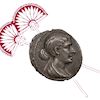
04. FOLDING FANS
There are two main types of folding fan. On the lower shelf you can see examples of the most common type: one which encompasses a set of sticks and a pleated leaf. On the middle shelf is another type. Consisting of a set of blades secured at the lower end with a rivet and threaded at the top with a ribbon or cord, this type is generally referred to as a brisé fan.VOICE BJapan is regarded as the birth place of folding fans, where the oldest surviving brisé (ogi in Japanese) dates from the eighth century. The earliest surviving pleated fans probably date from the 12th century when legend tells of a man who invented a fan having studied the wings of a bat. The Japanese call fans of this type Kawahori (or bat fan). VOICE AEurope’s earliest surviving folding fan dates from the sixth century and is preserved at the basilica of St John the Baptist at Monza. Queen Theodolinda’s fan, as it is commonly known, expands to a full circle. On the middle shelf, you can see a fan which opens in a similar way. This type of folding fan is called a cockade.
• To learn more about the development of folding fans in the West, press A. • To hear the Museum’s Curator discuss the so-called language of folding fans, press B.


The Fan Museum
The Fan Museum is the UK's only organisation of its kind, devoted entirely to the subject of fans and craft of fan making. Housed in two beautifully restored Georgian period townhouses, its collections number more than 7,000 objects dating from the 12th century to present day.
